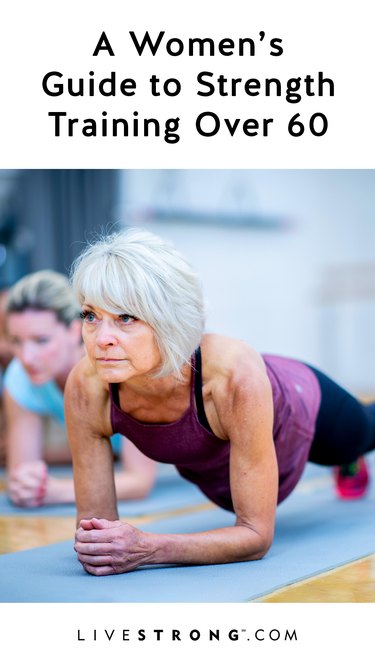
While you can't turn back time, you can slow the aging process and improve your physical ability by continuing with or starting a strength-training program in your 60s. Even a small amount of strength training can help reverse the muscle loss women experience as they age. Building and maintaining muscle mass not only helps you look and feel great, but also keeps you independent and healthy.
The Importance of Weightlifting for Older Women
Video of the Day
It is never too late to begin building lean muscle mass, levels of which begin to decline after age 30, particularly among sedentary people. Loss of muscle leads to loss of strength, which can make it harder to complete daily tasks as you age. Getting stronger will enable you to do more things for yourself as you get older, such as carrying your own groceries and mowing your own lawn — if you want to.
Video of the Day
Strength training also has other important benefits for your health:
Increases bone strength: Bone mass declines at a rate of 1 percent per year after age 40, according to Harvard Health Publishing. Weaker bones are more susceptible to fracturing, and can break with even a minor fall. Strength training puts pressure on the bones, which activates bone-forming cells to slow bone loss and build bone density.
Improves balance, coordination and mobility: This can help you avoid falls and remain independent longer. Falls are the leading cause of injury and death among older adults, according to the National Council on Aging.
Decreases body fat: Your metabolism slows as you age, but building more lean muscle mass can help. Muscle is more metabolically active than fat, so it increases the resting metabolism. Controlling your weight as you age is crucial, because having overweight or obesity are linked to many chronic diseases.
Prevents chronic health conditions: According to the Centers for Disease Control and Prevention, strength training can help prevent and improve arthritis, diabetes, osteoporosis, heart disease and back pain.
Improves mental health: Along with aerobic exercise, strength training can help reduce depression, increase confidence and self-esteem and improve sleep quality, all of which lead to an overall feeling of well-being.
Enhances cognitive function: Resistance training has positive effects on cognition, information processing, attention, memory formation and executive function, reports the American Council on Exercise.
Starting a Strength-Training Program
If you have not been doing any strength training — whether for a few years or forever — it's important to start resistance training gradually. Although you may be gung-ho and feel like you need to make up for lost time, being conservative with your efforts will help you start with a solid foundation and prevent injury so you can continue to strength train into your 70s and beyond.
Injuries are more easily sustained and harder to heal when you are older. This shouldn't prevent you from strength training, because building strength ultimately decreases your risk of injury in your daily life; however, it is important to keep in mind when planning a workout program.
You also want to make sure your program is challenging enough. Although even a little strength training can improve health and fitness parameters, more moderate to vigorous training will elicit greater results and, therefore, greater benefits. Starting slow and gradually increasing the amount and intensity of your strength training will continue to bring good results.
Read more: The Only 5 Exercises Women Need to Get Lean
Phase 1 Workouts for Older Women
In the first phase of weight training for women over 60, the goal is to build a solid foundation: improving the structural integrity of the body, working on movement patterns and technique, and improving muscle memory. Exercises in phase 1 should be low intensity, using just your own body weight or light weights/resistance bands.
Sample exercises include:
- Body-weight squats
- Lunges — side, forward, back
- Knee pushups
- Resistance band rows
- Plank
- Side plank
- Shoulder press
- Single-leg balance with movement
- Lateral side-step with resistance band
- Bicycle crunches
- Hamstring bridge
These exercises should be performed for one to three sets of 10 to 15 repetitions.
This first phase could last one month or one year, depending on where you started. Do two to three full-body workouts per week targeting all the major muscle groups — chest, back, arms, shoulders core and legs. When you feel stronger and confident with these basic moves, you can move on to more challenging exercises using more weight and intensity.
Increasing Exercise Intensity
When you've built a solid foundation, begin to increase the challenge by adding more complex movements and more weight. High-intensity exercise, both strength training and cardio, is effective for increasing the production of natural anabolic hormones (testosterone, growth hormone and insulin-like growth factor-1) that have anti-aging benefits.
You can still include exercises from phase 1, but increase the weight or the reps, perform the moves with more intensity and vary your lifting patterns, using a slow 2 count for the eccentric (lengthening) and concentric (contracting) phases of movement, or a 2 count for the eccentric phase and a 1 count for the concentric phase. There are many methods of varying a workout to keep things interesting and to keep challenging your muscles in new ways.
Circuit training is a powerful tool to increase the intensity of your workout and increase cardiovascular output at the same time that you build strength. To circuit train, perform one set of each exercise in your workout and then move to the next exercise without resting. Perform one to four rounds, with a brief rest between rounds.
Adding more complex exercises to your routine builds more strength and also improves coordination, range of motion, balance and other parameters of well-rounded physical fitness. Some examples of exercises to add in this stage include:
- Weighted squat
- Bench press
- Squat jumps
- Lunge jumps
- Deadlifts
- Single-leg deadlifts
- Bentover rows
- Step-ups
- Kettlebell swings
Modifications for Injuries
If you have injuries or other health problems, it is highly recommended that you have a physical therapist or certified personal trainer design a strength-training program for you. While injuries, chronic back or knee pain, and other health problems don't mean you shouldn't strength train, they do mean that you may need to modify certain exercises to avoid placing undue stress on particular areas of the body.
For example, if you have knee problems, you can perform shallower squats with your feet spaced slightly wider apart. You can also place your heels on a raised platform. Use light weights or your own body weight until you can perform the exercise comfortably.
If you're performing barbell squats and you have back problems, do back squats instead of front squats. Instead of a leg press, do stability ball squats against a wall. And when doing jumping exercises, avoid coming fully off the ground. Keep one foot on the floor while making the motion as if you were jumping, or simply step.
It's OK to Push Yourself
You'll see a lot of information on exercise for seniors that emphasizes low-intensity workouts. A lot of these sources frame people over the age of 60 as "fragile." Nothing could be further from the truth. Even if you've been sedentary for 30 years, you can build muscle and strength, balance and coordination.
Although new exercisers should take it slow, eventually you can — and should — add intensity to your workout to maintain and increase your fitness.
Click below to pin and save these strength-training tips for later!

Read more: Core Strengthening Exercises for Seniors
- BRN Fitness: The Benefits of Resistance Training for Older Adults
- Harvard Health Publishing: Preserve Your Muscle Mass
- Harvard Health Publishing: Strengthen Your Mood With Weight Training
- American Council on Exercise: Turn Back the Clock: How to Maximize the Anti-Aging Benefits of Exercise
- National Council on Aging: Falls Prevention Facts
- Harvard Health Publishing: Strength Training Builds More Than Muscles
- Commonwealth Sports Club: How to Modify Squats After a Knee Injury
- Arcadia Health: Exercise Modifications for Athletes With Lower Back Pain
- Centers for Disease Control and Prevention: Growing Stronger